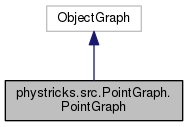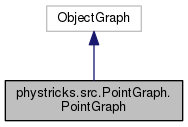|
phystricks
|
|
phystricks
|


Public Member Functions | |
| def | __init__ (self, a, b) |
| def | advised_mark_angle (self, pspict) |
| def | numerical_approx (self) |
| def | projection (self, seg, direction=None, advised=False) |
| def | symmetric_by (self, Q) |
| def | getPolarPoint (self, r, theta, pspict=None) |
| def | get_polar_point (self, r, theta, pspict=None) |
| def | getVisualPolarPoint (self, r, theta, pspict=None) |
| def | rotation (self, alpha) |
| def | value_on_line (self, line) |
| def | translate (self, a, b=None) |
translate self. More... | |
| def | origin (self, P) |
| def | Vector (self) |
| def | norm (self) |
| def | length (self) |
| def | normalize (self, l=None) |
| def | default_graph (self, opt) |
| def | default_associated_graph_class (self) |
| def | polar_coordinates (self, origin=None) |
| def | angle (self, origin=None) |
| def | coordinates (self, digits=5, pspict=None) |
| Return the coordinates of the point as a string. More... | |
| def | graph_object (self) |
| def | copy (self) |
| def | mark_point (self, pspict=None) |
| def | is_almost_equal (self, other, epsilon=0.0001) |
| def | tikz_code (self, pspict=None) |
| def | latex_code (self, language=None, pspict=None, with_mark=False) |
| def | __eq__ (self, other) |
return True if the coordinates of `self` and `other` are the same. More... | |
| def | __ne__ (self, other) |
| def | translation (self, v) |
| Translate the point with the vector. More... | |
| def | __add__ (self, other) |
| addition of coordinates More... | |
Public Attributes | |
| x | |
| y | |
| point | |
Private Member Functions | |
| def | _bounding_box (self, pspict=None) |
| def | _math_bounding_box (self, pspict=None) |
| Return a bounding box which include itself and that's it. More... | |
Private Attributes | |
| _advised_mark_angle | |
| def phystricks.src.PointGraph.PointGraph.__init__ | ( | self, | |
| a, | |||
| b | |||
| ) |
| def phystricks.src.PointGraph.PointGraph.__add__ | ( | self, | |
| other | |||
| ) |
addition of coordinates
| def phystricks.src.PointGraph.PointGraph.__eq__ | ( | self, | |
| other | |||
| ) |
return True if the coordinates of `self` and `other`
are the same.
INPUT:
other - an other pointOUTPUT:
boolean
This function tests exact equality (even symbolic if one needs). For numerical equality (up to some epsilon), use the function is_almost_equal
| def phystricks.src.PointGraph.PointGraph.__ne__ | ( | self, | |
| other | |||
| ) |
|
private |
return the bounding box of the point including its mark A small box of radius 0.1 (modulo xunit,yunit[1]) is given in any case. You need to provide a pspict in order to compute the size since it can vary from the place in your document you place the figure. [1] If you dont't know what is the "bounding box", or if you don't wan t to fine tune it, you don't care.
|
private |
Return a bounding box which include itself and that's it.
| def phystricks.src.PointGraph.PointGraph.advised_mark_angle | ( | self, | |
| pspict | |||
| ) |
| def phystricks.src.PointGraph.PointGraph.angle | ( | self, | |
origin = None |
|||
| ) |
Return the angle of the segment from (0,0) and self. Return type : MathStructure.AngleMeasure
| def phystricks.src.PointGraph.PointGraph.coordinates | ( | self, | |
digits = 5, |
|||
pspict = None |
|||
| ) |
Return the coordinates of the point as a string.
| digits | the number of digits that will be written in the return string |
| pspict | If given,
|
Some conversions and approximations are done. See number_to_string.
| def phystricks.src.PointGraph.PointGraph.copy | ( | self | ) |
| def phystricks.src.PointGraph.PointGraph.default_associated_graph_class | ( | self | ) |
Return the class which is the Graph associated type
| def phystricks.src.PointGraph.PointGraph.default_graph | ( | self, | |
| opt | |||
| ) |
Return a default Graph <opt> is a tuple. The first is the symbol to the point (like "*" or "none"). The second is a string to be passed to pstricks, like "linecolor=blue,linestyle=dashed".
| def phystricks.src.PointGraph.PointGraph.get_polar_point | ( | self, | |
| r, | |||
| theta, | |||
pspict = None |
|||
| ) |
| def phystricks.src.PointGraph.PointGraph.getPolarPoint | ( | self, | |
| r, | |||
| theta, | |||
pspict = None |
|||
| ) |
Return the point located at distance r and angle theta from point self.
INPUT:
- ``r`` - A number.
- ``theta`` - the angle (degree or :class:`AngleMeasure`).
- ``pspict`` - the pspicture in which the point is supposed to live. If `pspict` is given, we compute the deformation due to the dilatation. Be careful: in that case `r` is given as absolute value and the visual effect will not be affected by dilatations.
OUTPUT: A point.
EXAMPLES::
sage: from phystricks import *
sage: P=Point(1,2)
sage: print P.get_polar_point(sqrt(2),45)
<Point(2,3)>
| def phystricks.src.PointGraph.PointGraph.getVisualPolarPoint | ( | self, | |
| r, | |||
| theta, | |||
pspict = None |
|||
| ) |
| def phystricks.src.PointGraph.PointGraph.graph_object | ( | self | ) |
| def phystricks.src.PointGraph.PointGraph.is_almost_equal | ( | self, | |
| other, | |||
epsilon = 0.0001 |
|||
| ) |
| def phystricks.src.PointGraph.PointGraph.latex_code | ( | self, | |
language = None, |
|||
pspict = None, |
|||
with_mark = False |
|||
| ) |
| def phystricks.src.PointGraph.PointGraph.length | ( | self | ) |
The same as self.norm()
EXAMPLES::
sage: from phystricks import *
sage: P=Point(1,1)
sage: P.length()
sqrt(2)
| def phystricks.src.PointGraph.PointGraph.mark_point | ( | self, | |
pspict = None |
|||
| ) |
| def phystricks.src.PointGraph.PointGraph.norm | ( | self | ) |
Return the norm of the segment between (0,0) and self. This is the radial component in polar coordinates. EXAMPLES:: sage: from phystricks import * sage: Point(1,1).norm() sqrt(2) sage: Point(-pi,sqrt(2)).norm() sqrt(pi^2 + 2)
| def phystricks.src.PointGraph.PointGraph.normalize | ( | self, | |
l = None |
|||
| ) |
Return a vector of norm <l>. If <l> is not given, take 1.
| def phystricks.src.PointGraph.PointGraph.numerical_approx | ( | self | ) |
| def phystricks.src.PointGraph.PointGraph.origin | ( | self, | |
| P | |||
| ) |
Let S be the point self. Return the affine vector PK where K is such that PK=OS In other words, it return the affine vector O->self but attached on point P instead of O.
| def phystricks.src.PointGraph.PointGraph.polar_coordinates | ( | self, | |
origin = None |
|||
| ) |
Return the polar coordinates of the point as a tuple (r,angle) where angle is AngleMeasure
EXAMPLES::
sage: from phystricks import *
sage: Point(1,1).polar_coordinates()
(sqrt(2), AngleMeasure, degree=45.0000000000000,radian=1/4*pi)
sage: Point(-1,1).polar_coordinates()
(sqrt(2), AngleMeasure, degree=135.000000000000,radian=3/4*pi)
sage: Point(0,2).polar_coordinates()
(2, AngleMeasure, degree=90.0000000000000,radian=1/2*pi)
sage: Point(-1,0).polar_coordinates()
(1, AngleMeasure, degree=180.000000000000,radian=pi)
sage: alpha=-pi*(arctan(2)/pi - 2)
sage: Point(cos(alpha),sin(alpha)).polar_coordinates()
(1, AngleMeasure, degree=180.000000000000,radian=pi)
If 'origin' is given, it is taken as origin of the polar coordinates.
Only return positive angles (between 0 and 2*pi)
| def phystricks.src.PointGraph.PointGraph.projection | ( | self, | |
| seg, | |||
direction = None, |
|||
advised = False |
|||
| ) |
Return the projection of the point on the given segment. INPUT: - ``seg`` - a segment - ``direction`` - (default=None) a vector. If given, we use a projection parallel to `vector` instead of the orthogonal projection. OUTPUT: a point.
| def phystricks.src.PointGraph.PointGraph.rotation | ( | self, | |
| alpha | |||
| ) |
return a point that is the rotation of 'self' by the angle 'alpha' - alpha : the rotation angle (degree)
| def phystricks.src.PointGraph.PointGraph.symmetric_by | ( | self, | |
| Q | |||
| ) |
return the central symmetry with respect to 'Q'
| def phystricks.src.PointGraph.PointGraph.tikz_code | ( | self, | |
pspict = None |
|||
| ) |
| def phystricks.src.PointGraph.PointGraph.translate | ( | self, | |
| a, | |||
b = None |
|||
| ) |
translate self.
The parameter is
| def phystricks.src.PointGraph.PointGraph.translation | ( | self, | |
| v | |||
| ) |
Translate the point with the vector.
The parameter can also be a tuple of size 2.
| def phystricks.src.PointGraph.PointGraph.value_on_line | ( | self, | |
| line | |||
| ) |
Return the value of the equation of a line on `self`.
If $f(x,y)=0$ is the equation of `line`, return the number f(self.x,self.y).
NOTE:
The object `line` has to have an attribute line.equation
EXAMPLE::
sage: from phystricks import *
sage: s=Segment(Point(0,1),Point(1,0))
sage: s.equation()
x + y - 1 == 0
sage: P=Point(-1,3)
sage: P.value_on_line(s)
1
It allows to know if a point is inside or outside a circle::
sage: circle=Circle(Point(-1,2),4)
sage: Point(1,1).value_on_line(circle)
-11
::
sage: Point(1,sqrt(2)).value_on_line(circle)
(sqrt(2) - 2)^2 - 12
| def phystricks.src.PointGraph.PointGraph.Vector | ( | self | ) |
|
private |
| phystricks.src.PointGraph.PointGraph.point |
| phystricks.src.PointGraph.PointGraph.x |
| phystricks.src.PointGraph.PointGraph.y |
 1.8.11
1.8.11